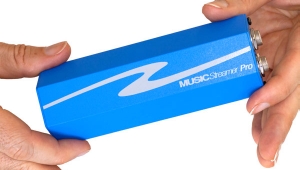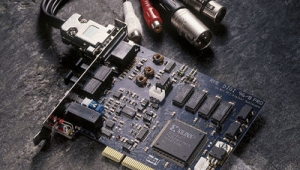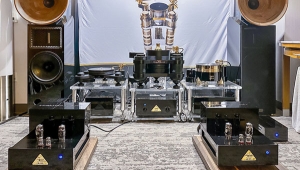| Columns Retired Columns & Blogs |
RME Digi96/8 Pro computer soundcard Page 3
I am generally not a big fan of TosLink data connections; their limited bandwidth, compared with ST-optical or AES/EBU, usually introduces data-related jitter. (See Malcolm Omar Hawksford and Chris Dunn's AES paper, "Is the AES/EBU Interface Flawed?," reprinted as "Bits is Bits?" in the March 1996 Stereophile.) But to my surprise, although I was hard-pressed to hear any difference at all between the RME's optical output and the AES/EBU output with the big Levinson processor, the TosLink sounded smoother in the high frequencies, less grainy, than an electrical S/PDIF connection with the inexpensive Musical Fidelity X-24K. In fact, auditioning some of my hi-rez piano masters, I would dare to suggest that 44.1kHz TosLink sounded smoother than 88.2kHz electrical. Heresy, I know.
I occasionally used dynamic headphones plugged into the Digi96/8's TRS jack to monitor what was going onto tape...er, hard drive. Either via headphones or taking the unbalanced outputs to the system preamp and listening over speakers, there was a hashy quality to the sound that I found fatiguing. Piano sounded too clangorous, vocals a bit grainy. Not for me, I'm afraid. The RME's analog outputs are not in the same class as those of the CardDeluxe's. For serious use I'd recommend treating the RME as a digital I/O unit.
RME's documentation for the Digi96/8 Pro is excellent, by the way, and goes into good detail on the various problems that have been encountered with different operating systems and programs.
Summing Up
At $450, the RME Digi96/8 Pro offers an excellent way of getting digital 24/96 audio data in and out of your computer, be it Mac or PC. Its analog outputs are okay for informal monitoring [see later], but for the best, true high-end sound quality, you should feed the RME's TosLink or AES/EBU data outputs to a standalone D/A processor.
Do I prefer it to the $595 CardDeluxe from Digital Audio Labs, which I reviewed in September? That's a hard one. Each card can be used as the basis for a multitrack digital audio workstation, the CardDeluxe using internal card-to-card jumpers, the German card by daisy-chaining the digital data output of one card to the digital data input of the next. (I believe the RME needs to be used with its $135 Word Clock Module for the best results.)
As you can read in this issue's Follow-Up, I had some compatibility problems with the CardDeluxe's S/PDIF data output and one of the processors I routinely use. The RME's S/PDIF and AES/EBU outputs, however, proved perfectly reliable with everything. And, to my surprise, the TosLink output sounded best with the less expensive D/A processor.
The extra $145 for the CardDeluxe buys you two excellent balanced-input A/D converters and two even-higher-resolution balanced-output D/A converters. On the other hand, the RME comes bundled with a very useful audio utility program, and can have four balanced analog inputs added for just $150.
As I said, a hard choice. I've chosen not to choose by having both installed in my PC. However, if you use a Mac or work with ADAT machines, or prefer to work with external A/D converters, the RME should get your nod.
Further Thoughts (from January 2001)
When I spilled some ink last November on this German 96kHz-capable PCI-bus card, I reviewed a sample that I had bought in 1999. However, as you could read in RME's "Manufacturer's Comment" (December 2000, p.223), the Digi96/8 Pro had since been significantly revised, and all the samples currently available in the US use a much-better-specified D/A converter for the analog monitor outputs. (The analog outputs on my earlier sample of the card had not featured very good performance, but because I used the card's digital inputs and outputs exclusively, this had not been an issue for me.) The US distributor therefore sent me a sample of current production for this Follow-Up.
Looking at the old and new versions of the Digi96/8 Pro, the differences were readily apparent. While the circuit blocks were all in the same places, with a Xilinx FPGA chip forming the heart of the card, the analog outputs carried on a ¼" stereo phone jack, and digital I/O carried both on TosLink optical connectors and in transformer-coupled electrical form (S/PDIF and AES/EBU) on a small D connector, the details were very different. Most important, the original's 20-bit AKM4321 DAC chip has been replaced by a 24-bit Analog Devices AD1852.
I therefore uninstalled the old card in the PC I use for music storage and replay and replaced it with the new Digi96/8 Pro. Windows 98 recognized the plug-and-play-compatible card when I turned on the computer, and I installed the latest driver software from the supplied CD-ROM.
The new card's analog output certainly sounded much better than the original's—cleaner, with less of a clangorous quality to recorded piano. Its measured performance was also much better (see "Measurements" sidebar).
The revisions to the RME Digi96/8 Pro's analog outputs have removed the one criticism I had to make of this otherwise excellent soundcard. I can enthusiastically recommend it to those wanting to integrate a computer into a high-end sound system.
- Log in or register to post comments

































